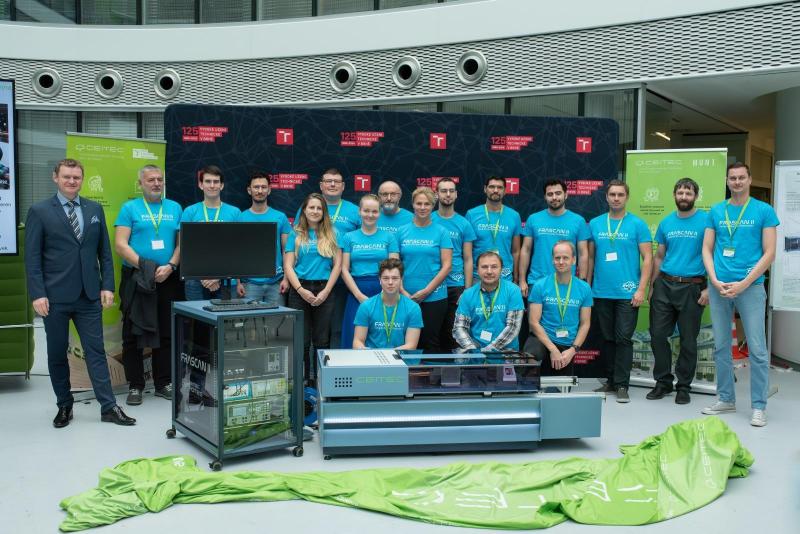Ideas and discoveries
Revolutionary spectrometer will help scientists understand protein structure and design new drugs

Brno, Czech Republic – Thursday, 17 October 2024 – Today, leading researchers from CEITEC Brno University of Technology unveiled a groundbreaking technological innovation: a state-of-the-art 329 GHz Electron Spin Resonance (ESR) spectrometer equipped with dynamic nuclear polarization (DNP) capabilities. This cutting-edge device, which has the potential to significantly advance materials science and molecular biology research, was presented during a grand unveiling ceremony attended by esteemed scientists and partners and held at CEITEC Masaryk University.
The unveiling event featured opening remarks by Jiří Nantl, the Deputy Minister of Education, Youth and Sports of the Czech Republic and a former director of CEITEC Masaryk University (MU), Martin Weiter, the Vice-Rector for Research and Knowledge Transfer at Brno University of Technology (BUT), Radimír Vrba, the Director of CEITEC BUT, and Pavel Plevka, his counterpart at CEITEC MU. Following the opening words, Petr Neugebauer, the Principal Investigator from CEITEC BUT, solemnly unveiled the spectrometer and provided an in-depth explanation of its purpose and function.
About the Spectrometer
The newly developed 329 GHz Electron Spin Resonance Spectrometer is a significant leap forward in scientific instrumentation. This advanced tool is designed to measure electron spin resonance (ESR), a phenomenon that occurs when electrons absorb specific electromagnetic waves under the influence of a magnetic field. The spectrometer can offer researchers unprecedented insight into the structural and material properties of various substances, making it an essential tool in material science, chemistry, and biology.
What sets this spectrometer apart is its dual functionality: it can measure both ESR and liquid-state nuclear magnetic resonance (NMR) simultaneously. This dual capability is made possible by incorporating a magnet of an NMR spectrometer, streamlining the equipment and reducing costs by eliminating the need for a separate magnet in a new system. In addition, the spectrometer boasts fast frequency scanning of up to 10^16 Hz per second, offering unparalleled speed and precision in studying electron spin relaxation properties at microwave frequencies around 329 GHz.

The team behind
This pioneering spectrometer is the result of a multi-disciplinary collaboration between scientists and international partners. The leader and principal investigator of the project is Petr Neugebauer (CEITEC BUT), with the critical NMR/EPR probe designed by Jan Dubský (CEITEC BUT), Petr Drexler and Martin Čáp (both FEEC BUT). The spectrometer’s quasi-optical bridge was supplied by Thomas Keating Ltd. (UK), while its 329 GHz components were sourced from Virginia Diodes Inc. (USA). The team, including Jan Dubský and Oleksii Laguta (CEITEC BUT), assembled and set up the device, with NMR tests conducted by Jan Dubský (CEITEC BUT) and Radovan Fiala (CEITEC MU).
The construction of the spectrometer was financed by the Grant Agency of the Czech Republic (GAČR) EXPRO grant.
Impact and Practical Applications
The ultimate goal of the spectrometer is to enhance NMR experiments through dynamic nuclear polarization. This technique amplifies NMR signals by transferring polarization from electron spins to nuclei, allowing scientists to study biomolecules, such as proteins, with increased sensitivity. The device’s potential to advance molecular research holds promise for future applications in drug development, disease diagnosis, and other biomedical innovations.
A Powerful Tool for Science
To put the spectrometer’s capabilities into perspective, it operates at frequencies 100 times higher than those used in mobile phones and generates a magnetic field 10 times stronger than those found in industrial scrap magnets. This immense power allows for the study of microscopic interactions that are essential to understanding complex biological and chemical processes.
For the general public, the unveiling of this spectrometer is an exciting step towards greater scientific discovery. Proteins, the building blocks of life, play a critical role in our body’s health and function. When proteins malfunction, diseases can arise. By using advanced magnetic resonance techniques, this spectrometer can help researchers better understand protein structures and design drugs that combat diseases at the molecular level.
Researchers involved in the project plan to publish their findings in leading scientific journals in the near future, showcasing the spectrometer’s far-reaching contributions to material sciences and molecular biology.
Marketing cookies must be enabled to play the video. You may change the setting here. You can open the video in a new panel.
Source: CEITEC BUT
Greater efficiency and completely new applications. Experts from FEEC BUT also collaborate on satellites for very low orbit
„Plastics will always be here, we just need to treat them differently," says the chemist Adriána Kovalčík, who has learned to face challenges
Scientists from FEEC BUT are participating in the development of a smart intersection. This could make transport more efficient and ensure greater safety
Smart dispatching system for virtual power plants co-developed by experts from FME BUT
Up to 400 gigabits per second. Experts from FIT BUT have developed one of the fastest accelerator network cards in the world



